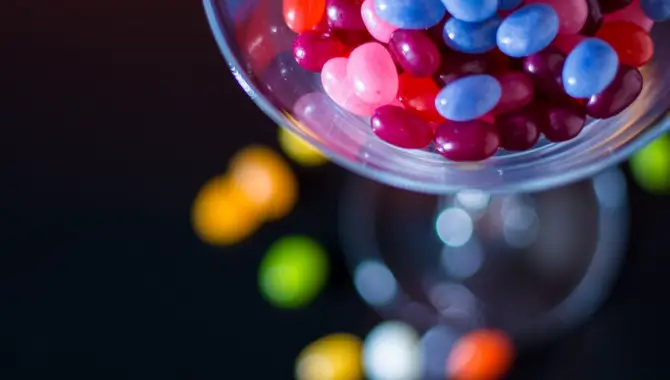Sweet foods and confectionery can be a bit of a minefield once you embark on a vegan lifestyle. For a start, there’s gelatin: an animal product found in all sorts of sweets, not just the chewy ones where you might expect to encounter it. Other pitfalls awaiting the unwary vegan include the waxes and glazes used to give some sweets their appealingly shiny coatings. Then there are the colorings and flavorings used to produce that rainbow of candy colors and flavors. Some of them are derived from animals, like carmine; others are chemical or plant-based but tested on various animals: rats, mice, rabbits, and even dogs. Fortunately, there are plenty of vegan substitutes out there to enjoy.
Are jelly beans vegan? Most are not. They’re usually made from non-vegan sugar and gelatine, colored with additives that were tested on animals, and varnished with beeswax and shellac (both animal-derived products). Vegan jelly beans exist, however.
Perhaps you’ve recently decided to become a vegan yourself, and you’re trying to find out which of your favorite foods you can still eat. Maybe you’re an established vegan and you want to add a new product to your shopping basket. Alternatively, you might have a vegan relative who you want to treat to some delicious candy. Whatever your situation, you’ve arrived here with questions.
- Are jelly beans vegan?
- Why are some sweets non-vegan?
- Which ingredients do you need to avoid?
- Are there any alternative products that vegans can enjoy?
Keep reading to find out everything a vegan should know about jelly beans and other confectionery.
Are jelly beans vegan?
With their enticing colors and variety of flavors, jelly beans are an iconic candy and a favorite of sweet-lovers everywhere. Unfortunately, this is one candy that vegans generally need to avoid. The list of non-vegan ingredients in most jelly beans would fill an encyclopedia.
First of all, there’s the dreaded gelatine. Gelatine seems to get everywhere. Gelatine is made by processing bones and other animal tissues leftover after mean processing. It’s brittle and hard when dry but can be hydrated to make jellies and chewy sweets. Gelatine is popular in the food industry because it gives foods an appealing texture while being colorless and largely flavorless. As an animal ingredient, it’s one of the substances that vegans need to avoid.
Next, there’s the sugar used to produce that sweet taste. The concept of non-vegan sugar may be an unpleasant surprise to a lot of people when they switch to a vegan lifestyle. As a plant product, you’d think sugar would be safe. Unfortunately, cane sugar is often refined using a process that involves bone char. As the name suggests, this material is made from animal bones that are heated to a very high temperature. The resulting material is a highly effective filter. Sugar produced in this way is, obviously, not suitable for vegans. You’ll be glad to know that a great deal of cane sugar is refined using other methods. Beet sugar is never purified with bone char, so it’s safe for vegans to use.
Then there are the colorings used to give jelly beans their array of jolly shades. Many of these colorants — tartrazine, indigotin, Sunset Yellow, to name but a few — are heavily tested on animals. Even if your veganism is more of a healthier choice than a matter of ethics, you may still decide to eschew artificial colors as they can be very unhealthy to consume. Then there’s carmine, also known as cochineal. Although artificial versions exist, much of this red dye is still made the old-fashioned way: from the secretions of dying insects.
The flavorings used in some brands of jelly beans may also be suspect. Some of them are derived from animal sources, while others were tested on animals during and after development. The catch-all term “natural flavor” should be a red flag here — it’s used for a range of different substances, many of them derived from or tested on animals.
As if that wasn’t enough, there’s the shiny coating that makes jelly beans glisten so enticingly. Well, that’s very likely made using beeswax and shellac. Beeswax is the edible wax produced by bees to make the internal structures of their hives; it’s an animal product and therefore not suitable for vegans. Shellac is arguably even worse. This shiny varnish-like coating is made by insects, which secrete a substance called lac. Lac is collected up and dissolved in alcohol to produce shellac. This is then used in furniture varnishes, nail polish — and on your candies if you’re not careful.
Do vegan jelly beans exist?
Despite this litany of animal-based ingredients, it’s perfectly possible to make delicious jelly beans without resorting to non-vegan substances. The main offender — gelatine — is very easy to replace. Plant-based gums and gelling agents such as agar-agar are completely vegan and make excellent sweets.
Next, it’s simple enough to swap out non-vegan cane sugar for beet sugar. Vegan cane sugar, refined without resorting to bone char, would also be suitable. Beet sugar and vegan cane sugar have very similar characteristics to sugar refined using bone char, so the substitution should not present any problems for the manufacturer.
Then there are the colorings and flavorings, which are also very easy to substitute. There are plenty of safe, cruelty-free flavors to use. Artificial colors can be swapped out for natural dyes made from vegetable sources: a strong green can be derived from spinach, bright pinks and reds can be extracted from beetroots, and anyone who’s ever tried to wash a curry stain out of a white shirt can attest to the rich yellows and oranges produced by turmeric. Other common sources of color include fruits and even herbs such as nettles.
Finally, there’s the confectioner’s glaze. Candy manufacturers who want to give their products an appealing shiny coating do not have to use beeswax or shellac. Instead, soy wax can be used, or other edible plant-based waxes. Technically there is no need for waxes at all, but they do make the candy look prettier and stop it sticking together in the packaging. Confectioner’s glaze also seals in the flavor and means that each bean keeps its distinct taste.
Which brands of jelly beans are vegan?
There’s no easy answer to this. The ingredients that large international brands use may vary widely from country to country, thanks to different regulatory standards and the price of ingredients. Even within a single country, a manufacturer may often change the ingredients of their product without warning due to fluctuations in availability, price and consumer demand. For example, some Haribo confectioneries are vegan in parts of Europe because they use vegetable ingredients and beet sugar, while a similar product made by the same company might use cane sugar or beeswax when marketed elsewhere.
Thus, if you want to try and purchase jelly beans from a mainstream confectionery manufacturer, you will have to be very diligent about checking the ingredients. Some brands worth investigating include the aforementioned Haribo, Warheads, and Wonka. Jolly Rancher is also noted for producing vegan-friendly jelly beans.
It’s also worth keeping in mind that if you buy from a mainstream candy manufacturer, you are inevitably supporting a company that trades in animal-derived products and products that are not cruelty-free. Some vegans find this unacceptable, at least as a regular practice.
Your best bet, if you want to avoid any animal ingredients whatsoever, is to buy jelly beans and other sweets from a vegan manufacturer. Some manufacturers mean well but don’t really know what they’re doing vis-a-vis vegan ingredients, whereas a fully vegan company knows their stuff and will avoid substances like non-vegan sugar.
Many vegan manufacturers also offer organic products. Not only are organic sweets much healthier but they are also more environmentally friendly. One big advantage of adopting a vegan lifestyle is that you reduce your environmental impact at a stroke; by going organic too, you can improve things even more. Vegan producers are frequently concerned with related ethical issues, such as obtaining fair-trade sugar and other ingredients.
Is it possible to make vegan jelly beans at home?
If you want complete control over every ingredient in your sweets, there’s nothing like making your own candy. Jelly beans are a bit more effort than other candies because you’ll need to make several batches if you want a nice mix of flavors, but they’re certainly worth it.
To make your own vegan jelly beans, you will need beet sugar or vegan cane sugar, agar-agar or another vegan gelling agent, plus whatever vegan flavorings and colorings you like best. You can pick these up from your local health food outlet or shop online — they’re easy to find. You’ll also need a jelly bean mold; these are a bit trickier to find but you can often pick them up at specialist baking stores. The silicone ones are easiest to use.
Now you have all your ingredients, it’s time to prepare the jelly mixture. Use about half the liquid recommended on the vegan jelly packets — your sweets need to be fairly stiff. Heat up the water and mix in your vegan sugar, adding a little at a time until no more will dissolve. You may need to cool the mixture a little before you add the gelling agent (refer to the packet, as this will depend on the type you use).
Once you have your unflavoured vegan jelly mixture, it’s a matter of flavoring it to taste. You’ll want three or four flavors for that rainbow jelly bean experience. Pour some of the jelly mixtures into a heat-proof container and add the flavor and coloring, then pour it into one of the moulds. Do this until you have no more jelly mixture left. Allow your jelly beans to set, preferably overnight.
Once the candy has set, pop the beans out of the mould and enjoy.
Welcome to VeganClue - My name is Robert Van De Ville and together with my team we spent hundreds of hours researching the most relevant topics for Vegans and non yet Vegans. Are you looking for more information about Veganism, animal welfare, diet, health, and environmental benefits of the Vegan lifestyle? You are in the right place! Enjoy the site.

